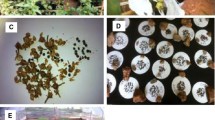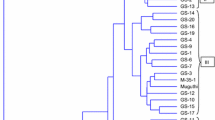Abstract
Cassava (Manihot esculenta Crantz) brown streak disease (CBSD) is currently one of the major constraints to sustained cassava production in Malawi. Its economic impact is mainly manifested in the storage roots where it causes pitting, necrosis and constriction. CBSD can effectively be managed by using resistant varieties as well as early harvesting especially if the varieties are early bulking (high storage root yield). However, development of resistant and high storage root bulking varieties requires an understanding of gene action controlling inheritance of the two traits. Currently, there is very little information in Malawi regarding the inheritance pattern and relative importance of general (GCA) and specific combining ability (SCA) of these two traits. Therefore, a study was conducted to determine mode of gene action as well as importance of GCA and SCA in the genetic control of CBSD resistance and storage root yield. Information generated is essential in the selection of parents and breeding strategies for an effective breeding programme. Thirty-six crosses were generated using a 6 × 6 North Carolina Design II and later evaluated for CBSD resistance and storage root bulking at two locations using a triple square lattice design. Data for the progenies were analysed using REML in Genstat (17th ed.) while family (crosses) data were analysed using a PROC Mixed procedure performed in SAS® 9.3 Software. The GCAf × location, GCAm × location and SCA × location interaction effects were highly significant (P < 0.01) for CBSDS and CBSDI. Pooled analysis across two locations showed highly significant (P < 0.01) variance among GCA due to females (GCAf) and GCA due to males (GCAm) for FSRY. These GCAf, GCAm and female × male interaction (SCA) effects accounted for 19.8, 33.4 and 46.7% of the sum of squares for CBSDS, respectively. The results suggested that additive gene effects predominantly controlled CBSD resistance and high storage root bulking. Four parental genotypes (Silira, Mulola, Phoso and Mkondezi) were identified as the best general combiners for the CBSD, high storage root bulking and other traits. Thirteen progenies exhibiting CBSD resistance and high storage root bulking were identified and selected for advancement.


Similar content being viewed by others
References
Acquaah G (2012) Principles of plant genetics and breeding, 2nd edn. Wiley, Chichester
Alvarez E, Llano GA, Mejía JF (2012) Cassava diseases in Latin America, Africa and Asia. In: Howeler RH (ed) The cassava handbook: a reference manual based on the asian regional cassava training course, held in Thailand Centro Internacional de Agricultura Tropical (CIAT), Bangkok, Thailand, pp 258–304
Benesi IRM, Labuschagne MT, Herselman L, Mahungu N (2010) Ethnobotany, morphology and genotyping of cassava germplasm from Malawi. J Biol Sci 10:616–623
Cach TN, Lenis JI, Pérez JC, Morante N, Calle F, Ceballos H (2006) Inheritance of relevant traits in cassava (Manihot esculenta Crantz) for sub-humid conditions. Plant Breed 125:177–182
Calle F, Perez JC, Gaitán W et al (2005) Diallel inheritance of relevant traits in cassava (Manihot esculenta Crantz) adapted to acid-soil savannas. Euphytica 144:177–186
Calvert LA, Thresh JM (2002) The viruses and virus diseases of cassava. In: Hillocks RJ et al (eds) Cassava: biology, production and utilization. CABI, Wallingford, pp 237–260
Ceballos H, Iglesias CA, Perez JC, Dixon AG (2004) Cassava breeding: opportunities and challenges. Plant Mol Biol 56:503–516
Ceballos H, Kulakow P, Hershey C (2012) Cassava breeding: current status, bottlenecks and the potential of biotechnology tools. Trop Plant Biol 5:73–87
Ceballos H, Kawuki RS, Gracen VE, Yencho GC, Hershey CH (2015) Conventional breeding, marker assisted selection, genomic selection and inbreeding in clonally propagated crops: a case study for cassava. Theor Appl Genet 128:1647–1667
Chikoti PC (2011) Development of cassava (Manihot esculenta Crantz) cultivars for resistance to cassava mosaic disease in Zambia. Dissertation, University of Kwazulu-Natal
Chipeta MM (2012) Determination of combining abilities and mode of gene action for insect pests and disease resistance in cassava (Manihot esculenta Crantz) in Malawi. Dissertation, University of Malawi
Chipeta MM, Shanahan P, Melis R, Sibiya J, Benesi IRM (2016a) Farmers’ knowledge of cassava brown streak disease and its management in Malawi. Int J Pest Manag 62:175184
Chipeta MM, Shanahan P, Melis R, Sibiya J, Benesi IRM (2016b) Early storage root bulking index and agronomic traits associated with early bulking in cassava. Field Crops Res 198:171–178
Comstock RE, Robinson HF (1952) Estimation of average dominance of genes in heterosis. Iowa State College Press, Ames, pp 494–516
Falconer DS, Mackay TFC (1996) Introduction to quantitative genetics, 4th edn. Longman Group Ltd., Harlow
Fukuda WMG, Guevara CL, Kawuki R, Ferguson ME (2010) Selected morphological and agronomic descriptors for the characterization of cassava. International Institute of Tropical Agriculture (IITA), Ibadan
Gondwe FMT, Mahungu NM, Hillocks RJ et al (2003) Economic losses experienced by smallscale farmers in Malawi due to cassava brown streak virus disease. In: Legg JP, Hillocks RJ (eds) Cassava brown streak virus disease: past, present and future. Proceedings of an international workshop. Natural Resources International Ltd, Mombasa, p 100
Griffing B (1956a) A generalised treatment of the use of diallel crosses in quantitative inheritance. Heredity 10:31–50
Griffing B (1956b) Concept of general and specific combining ability in relation to diallel crossing systems. Aust J Biol Sci 9:463–493
Hillocks RJ, Jennings DL (2003) Cassava brown streak disease: a review of present knowledge and research needs. Int J Pest Manag 49:225–234
Hillocks RJ, Raya MD, Mtunda K, Kiozia H (2001) Effects of brown streak virus disease on yield and quality of cassava in Tanzania. J Phytopathol 149:389–394
Hinkelmann K (ed) (2012) Design and analysis of experiments, special designs and applications, 3rd edn. Wiley, New York
IITA (1990) Cassava in tropical Africa. Chayce Publication Services, London
Institute SAS (2011) SAS Software release 9.3. SAS Institute Inc, Cary
Kamau J, Melis R, Laing M, Derera J, Shanahan P, Ngugi E (2010) Combining the yield ability and secondary traits of selected cassava genotypes in the semi-arid areas of Eastern Kenya. J Plant Breed Crop Sci 2:181–191
Kawano K (1980) Cassava. In: Fehr WR, Hadley HH (eds) Hybridization of crop plants. ASA and CSSA, Madison, pp 225–233
Kulembeka H, Ferguson M, Herselman L et al (2012) Diallel analysis of field resistance to brown streak disease in cassava (Manihot esculenta Crantz) landraces from Tanzania. Euphytica 187:277–288
Legg JP, Thresh JM (2003) Cassava virus diseases in Africa. In: Proceedings of the first international conference on plant virology in Sub-Saharan Africa. IITA, Ibadan, Nigeria, pp 517–552
Legg JP, Jeremiah SC, Obiero HM, Maruthi MN, Ndyetabula I, Okao-Okuja G et al (2011) Comparing the regional epidemiology of the cassava mosaic and cassava brown streak virus pandemics in Africa. Virus Res 159:161–170
Lokko Y, Dixon AGO, Offei SK, Danquah EY (2006) Combining ability analysis of resistance to mosaic virus disease in cassava. Afr Crop Sci J 14:221–230
Moyo CC, Benesi IRM, Sandifolo VS, Teri JM (1999) Current status of cassava and sweet potato production and utilization in Malawi. In: Akoroda MO, Teri JM (eds) Food security and crop diversification in SADC countries: the role of cassava and sweet potato. IITA, Ibadan, pp 51–68
Mtunda KJ (2009) Breeding, evaluation and selection of cassava for high starch content and yield in Tanzania. Dissertation, University of Kwazulu-Natal
Munga TL (2008) Breeding for cassava brown streak disease resistance in Coastal Kenya. Dissertation, University of Kwazulu-Natal
O’Neill M (2010) ANOVA & REML. A guide to linear mixed models in an experimental design context. Statistical Advisory & Training Service Pty Ltd, Blackheath
Ojulong HF (2006) Quantitative and molecular analyses of agronomic traits in cassava (Manihot esculenta Crantz). Dissertation, University of the Free State
Parkes EY (2011) Assessment of genetic diversity, combining ability, stability and farmer preference of cassava germplasm in Ghana. Dissertation, University of the Free State
Payne RW, Welham S, Harding S (2014) A guide to REML in GenStat. VSN International, London
Shaba ER, Chipungu F, Mazuma EDL (2003) Cassava brown streak virus disease in Malawi. In: Legg JP, Hillocks RJ (eds) Cassava brown streak virus disease: past, present and future. Proceedings of an international workshop. Natural Resources International Ltd, Mombasa, p 100
Singh RK, Chaudhary BD (1985) Biometrical methods in quantitative genetic analysis. Kalyani Publisher, New Delhi
Tumuhimbise R (2013) Breeding and evaluation of cassava for high storage root yield and early bulking in Uganda. Dissertation, University of KwaZulu-Natal
Were WV (2011) Cassava breeding through complementary conventional and participatory approaches in western Kenya. Dissertation, University of KwaZulu-Natal
Winter S, Koerbler M, Stein B, Pietruszka A, Paape M, Butgereitt A (2010) Analysis of cassava brown streak viruses reveals the presence of distinct virus species causing cassava brown streak disease in East Africa. J Gen Virol 91:1365–1372
Zacarias AM, Labuschagne MT (2010) Diallel analysis of cassava brown streak disease, yield and yield related characteristics in Mozambique. Euphytica 176:309–320
Acknowledgements
Chitala Agricultural Research Station and Bunda College of Agriculture that provided land and technical support for the trials. Special thanks to Fabiano Thulu and Alex Mwale for their assistance in data collection and entry. Alliance for a Green Revolution in Africa for the financial support towards the study and the African Centre for Crop Improvement for coordinating research activities.
Author information
Authors and Affiliations
Corresponding author
Rights and permissions
About this article
Cite this article
Chipeta, M.M., Melis, R. & Shanahan, P. Gene action controlling cassava brown streak disease resistance and storage root yield in cassava. Euphytica 214, 104 (2018). https://doi.org/10.1007/s10681-018-2196-1
Received:
Accepted:
Published:
DOI: https://doi.org/10.1007/s10681-018-2196-1




